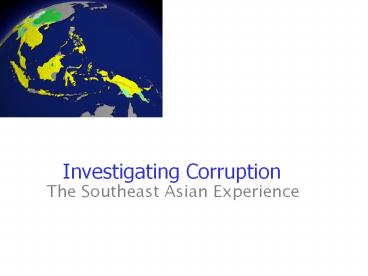Investigating Corruption - PowerPoint PPT Presentation
1 / 25
Title: Investigating Corruption
1
- Investigating Corruption
The Southeast Asian Experience
2
Traditionally closed areas of public life have
been made more open and transparent.
- What officials own.
- Corruption in public office.
- How decisions and policies are made.
- How much elections cost.
- Who finances campaigns.
3
I. Investigating Assets (the fruits of corruption)
- Comparing asset statements (financial
disclosures) with actual assets - Showing disparities between what is declared and
what is actually owned by examining other public
records - Exposing how officials hide assets (through
dummies) or inflate liabilities (through fake
loans)
4
Investigating EstradaFirst Lead How we began
- We got reports from that fancy mansions were
being built for mistresses of the President.
There were persistent rumors of big amounts of
money being given to the President in exchange
for government contracts. - There were reports that mistresses of the
President were involved in various businesses.
5
What we Found from Corporate Search
- Estrada and his families are listed as board
members of 66 corporations but declared less than
10 companies in his statement of assets. The
assets of 14 companies alone total more than P600
M (US12 M). - But in 1999, Estrada declared a net worth of
P35.8M (US760,000) and a net income of P2.3M
(46,000).
6
Land Records Showed
17 Properties worth over P2 billion (40M)
7
(No Transcript)
8
(No Transcript)
9
(No Transcript)
10
(No Transcript)
11
Paper Trail for Investigating Assets
- Statements/Declarations of Assets
- Property Records
- - Land
- - Companies
- - Vehicles
- Licenses and permits (for businesses, etc.)
- Listings, records of trade and professional
organizations - Biographies, news articles, family histories
12
Paper Trail for Investigating Assets
Cars in Congress
- Houses
- Vehicles (cars, yachts, planes)
- Jewelry, Clothes
- Hobbies, recreation
- Social affiliations
- Bars, restaurants and shops frequented
- Foreign travel
- Schools of children
13
II. Investigating Petty Corruption
- Interviews with victims or eyewitnesses
- Undercover or surveillance-type investigations
- Simple observation
- Participant-observation
14
III. Investigating the consequences of corruption
15
Corruption in Philippine education
- Payoffs eat up 20 to 65 of textbook funds.
Because of corruption, textbookpupil ratio is
only 16 in grade school and 18 in high school.
The public school system lacks 70 million
textbooks. - Under-deliveries range from 30 to 60 of the
total contract. 3.5 million of 15 million
schoolchildren do not have a desk or chair.
16
Validating corruption in the field
Unfinished Bridge in Abra
17
Estimating the costs of corruption
175-garbage can
Sterilizer bought for 29,000 Actual price 250.
Pencils at 2 each
18
IV. Investigating Conflicts of Interest Business
Interests of Congressmen
19
Databases on line
- ?Assets of officials
- http//www.i-site.ph
- ?Political families
- Political Clans
- Cost of legislation
- Fewer laws, bigger budget
20
What types of stories succeed?
- Well documented evidence of scandalous,
individual wrongdoing in high places especially
lifestyles - Sustained reporting on an issue of wide public
interest e.g. education - When public is outraged
- When there are reform-oriented politicians or
factions pushing for change - Timely release
21
What types of stories are more difficult?
- Systemic, instead of individual, wrongdoing
- Complex stories that are hard to explain or to
document - Stories that have no fixed constituencies
- Stories that involve conflict of interest and
other forms of unethical, but not necessarily
illegal, behavior where the wrongdoing is not
immediately obvious
22
Despite more openness, money politics and
corruption continue.
- The press is generally more successful in
toppling old regimes than in positively shaping
new ones.
23
Of 100 Filipino journalists surveyed...
- 71 had been offered money by their sources
- 33 said they took the money 22 kept it while 11
turned it over to their editors
24
In Indonesia
- In 2001, 64 state-owned companies and government
departments set aside 173 million for pembinaan
wartawan or cultivating journalists. - Alliance of Independent Journalists 2001 survey
70 percent of journalists in East Java and 97
percent in Jakarta admitting to taking envelops
of cash.
25
What needs to be done
- Upgrade research reporting skills
- Provide editorial support direction
- Address issues of ethics and journalists pay
- Ensure access to information
- Protect sources
- Protect journalists








![❤[READ]❤ The Shame of the Cities: The Famous Muckraking Expose of Corruption in PowerPoint PPT Presentation](https://s3.amazonaws.com/images.powershow.com/10051147.th0.jpg?_=20240608111)






















